13 Different Option Strategies That Investors Should Know
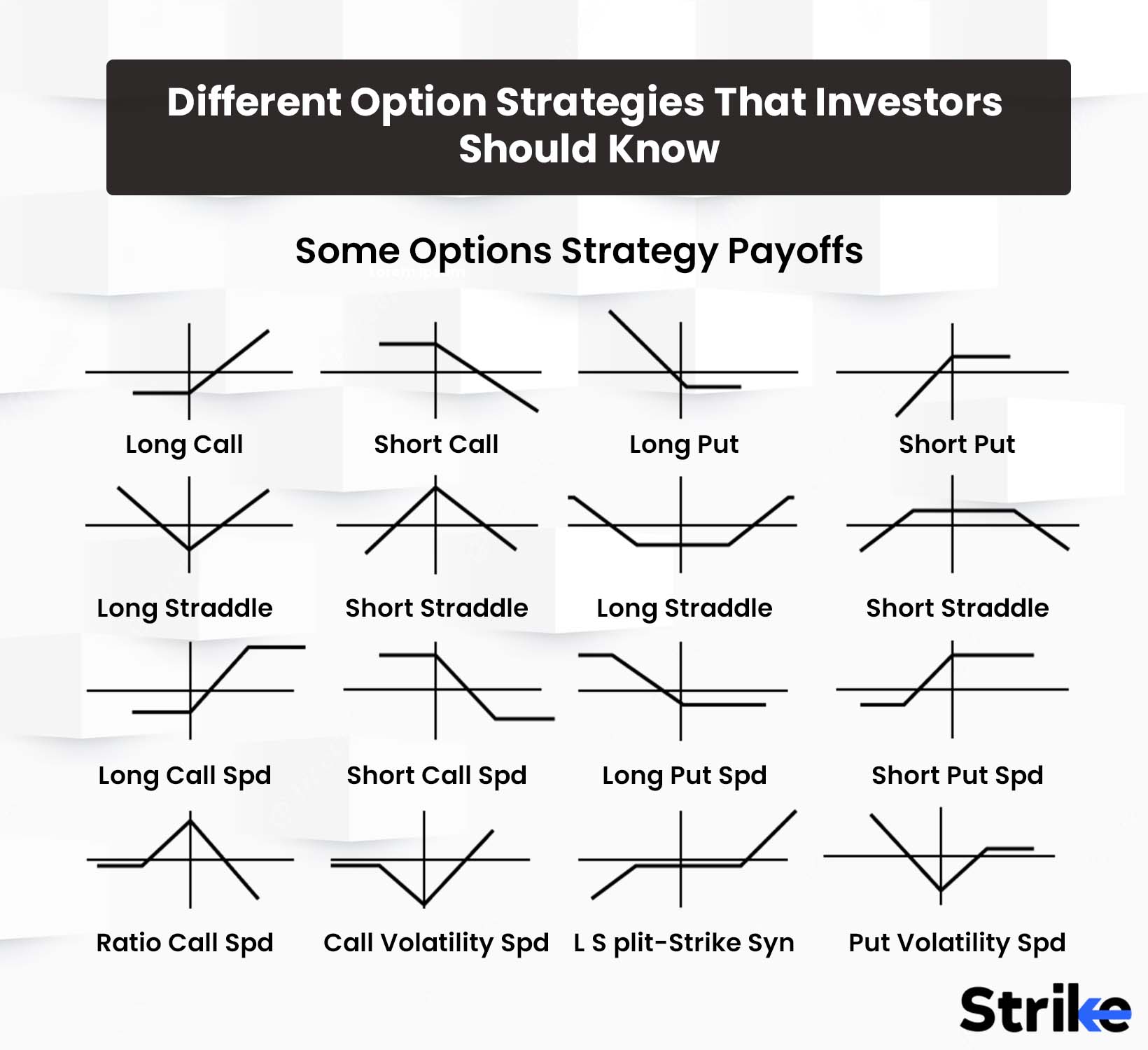
An options strategy refers to simultaneously buying or selling a combination of call and put options to achieve a particular risk/reward profile. Options strategies range from conservative approaches like covered calls to higher-risk tactics like naked puts. The goal is to structure positions that benefit from a stock’s expected price movement and volatility.
Options derive value from the price movement of an underlying stock. Strategies combine options at various strike prices and expiration dates to profit from the stock’s potential moves. For example, a covered call sells upside call options against stock already owned to generate income from premiums.
A straddle involves simultaneously buying call and put options with the same strikes and dates to benefit from a substantial price swing in either direction. Below are the 15 best option strategies for option trading.
1. Collar
A zero-cost collar, also known as a collar options trade, involves purchasing protective puts and selling offsetting out-of-the-money calls against the stock in your portfolio. This collar strategy results in a position with a built-in cap and floor due to the income from the short call covering the cost of the long put. The stock position will likely be called away if the stock price exceeds the call strike at expiration. The put strike determines the lowest possible stock price before the put counteracts further losses. The collar strategy sets a range within which the investor maintains the stock position without requiring additional cash.
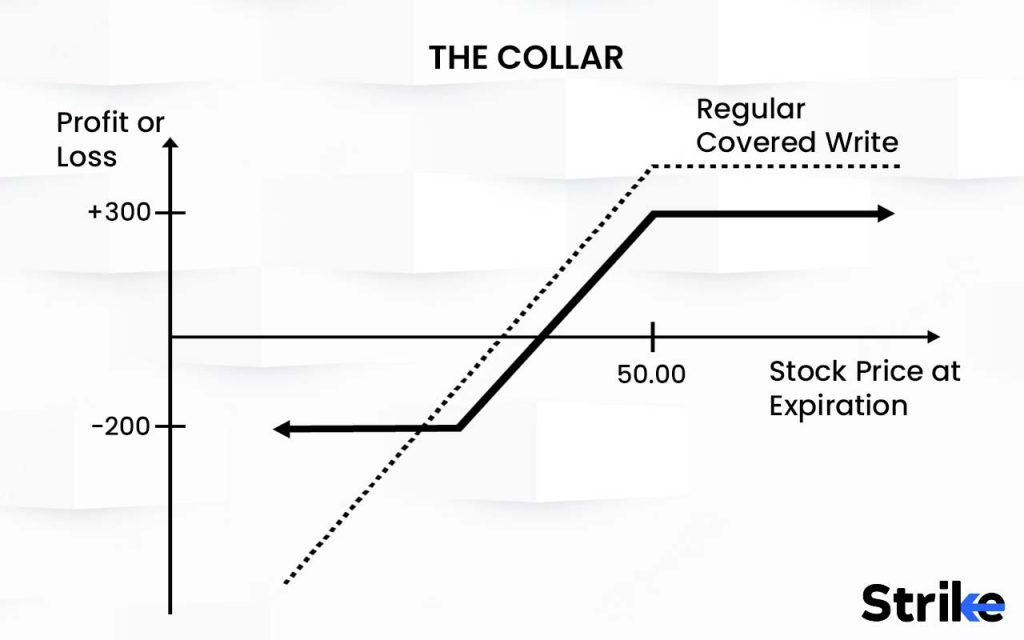
This collar strategy presents traders with a number of appealing benefits, making it an attractive option. Downside protection comes first, provided by the long puts, which hedge against declines below the defined floor price, limiting maximum losses should the underlying stock decrease. The generation of premium income through the selling of covered calls serves as the second benefit, which offsets the cost of the protective puts, thereby creating a built-in funding mechanism within the structure of the trade.
The third benefit is the clear definition of the maximum possible gain and loss by the call-and-put strikes, which provides a defined and limited risk profile. Fourthly, a proper collar construction results in a zero net debit, meaning it eliminates the need for out-of-pocket costs. Lastly, the investor retains exposure to the upside up to the call strike, allowing for participation in gains up to that level.
The collar strategy becomes particularly effective under certain market conditions. The investor should expect the stock to rise modestly or at least remain steady, indicating a moderately bullish outlook. As it maximizes the call premium collected relative to the cost of the put, lower volatility in the underlying optimizes the trade. A willingness to sell the stock should exist if it rallies above the call strike and is assigned at expiration. The collar strategy also performs best with a stock that does not pay dividends, as calls lose value when the stock goes ex-date.
Constructing a zero-cost collar involves several important steps. Initially, purchase protective puts at a strike below the current stock price, selecting a level that represents your maximum acceptable loss. Then, sell out-of-the-money calls above the current stock value, choosing a strike where you would be willing to sell the shares. Matching the number of puts and calls bought and sold is the third step, followed by adjusting the strike prices to achieve zero net debits for the entire trade. For simplicity, consider using the same expiration date. A higher chance of success comes with a wider spread between the put and call strikes, but spreads that are too wide might not achieve the zero-cost objective.
The collar approach carries both advantages and limitations worth considering. Positively, it provides protection for the downside of the stock, generates income from call premiums, carries defined and limited risk, eliminates the need for cash outlay, and retains some upside exposure. The main negatives include a cap on the upside if the stock rallies beyond the call strike, an obligation to own the shares, dividend risk if assigned early, a potential for financial loss if it expires between strikes and an effect of time decay on the long puts.
Collar trades provide investors with a method to hedge their stock holdings at zero or minimal cost. They establish a range for holding the stock without the need for additional capital by buying protective puts and selling covered calls. While these collars restrict maximum gains and losses, active management allows for flexibility. Zero-cost collars represent an accessible risk management approach worth considering for equity investors with a moderately positive outlook seeking protection against declines.
2. Straddle
A straddle refers to simultaneously buying an at-the-money call and putting it with the same underlying stock, strike price, and expiration date. A straddle secures the right to purchase the stock through the call if it rallies and the right to sell it through the put if it declines. These concurrent long positions create an unlimited profit potential if the stock significantly moves up or down. However, they also carry a risk limited by the net debit paid for the options. The primary objective is for the stock to swing beyond the breakeven points on either side by expiration.
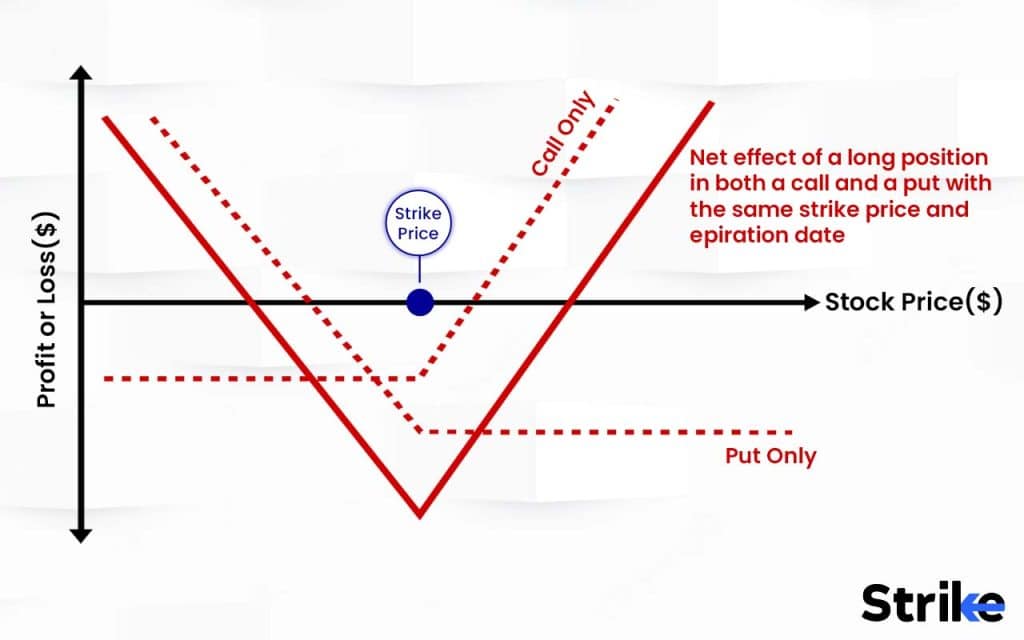
Straddles capture large price swings in either direction, reaping substantial upside or downside momentum. Thanks to the dual long positions in calls and puts, traders can profit regardless of the stock’s direction. The risk is defined and limited to the net debit paid for the options. Leveraged percentage returns become achievable if the stock’s movement surpasses the breakeven points. Straddles also facilitate making earnings bets based on predicted stock reactions.
Straddles emerge as an ideal strategy under specific conditions. Upcoming catalyst events such as earnings reports, FDA decisions, product launches, and other releases create a favorable environment for volatility. Low implied volatility offers relatively inexpensive option pricing to establish the trade. High expected volatility denotes the potential for a major price swing in either direction. The wider the stock’s typical daily trading range, the more room there is for a profitable move.
Constructing a straddle requires several actions. Firstly, identify a stock with an expected catalyst or earnings date. Purchase a near-term at-the-money call option with a strike near the current stock price. Then, procure the same expiration at-the-money put with an identical strike. Ensure the number of calls and puts purchased match. Buying options one strike in- or out-of-the-money offers added leverage. Assess the trade’s risk-reward scenarios, taking into account the total debit paid.
Straddles bring both advantages and disadvantages. Potential benefits include profiting from large price swings, exposure to both upside and downside, limited defined risk, and high returns if the movement surpasses the breakeven. Potential drawbacks are losses if the stock remains flat, increased debit costs in high volatility, time decay without movement, early assignment risks, and mistimed entry.
The performance of straddles largely depends on the timely occurrence of catalysts and the magnitude of the stock’s price swing. Straddles should be applied selectively based on thorough research and analysis.
Straddles represent an interesting options strategy for traders expecting a substantial spike in volatility ahead of a major catalyst event. By purchasing calls and puts on the same stock, investors position themselves to profit from price swings beyond the breakeven points in both upward and downward directions. However, this dual exposure carries defined risks of loss if the movement does not materialize before expiration. Properly used under the appropriate market conditions, straddles offer a compelling method to navigate impending stock-moving events.
3. Strangle
A strangle is created by buying an out-of-the-money call option and an out-of-the-money put on the same underlying stock with the same expiration date. A strangle establishes a long position with unlimited profit potential if the stock makes a strong move up or down. The maximum loss is limited to the net debit paid to open the strangle if the stock fails to move much by expiration. A key advantage over straddles is lower pricing since the options are OTM. The goal is for the stock to move past either strike price enough to offset the debt costs.
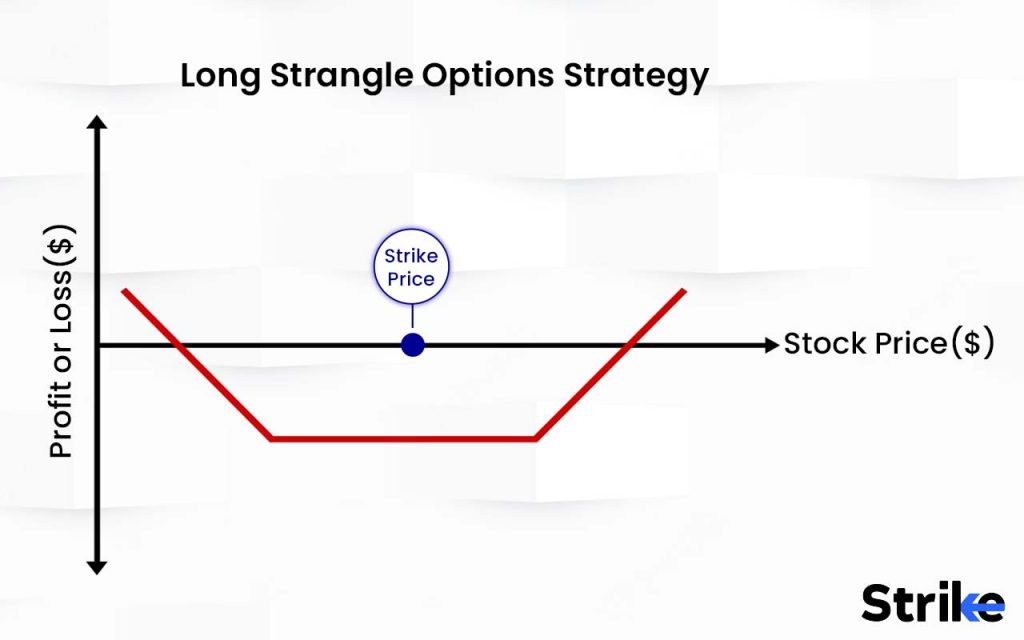
Strangles offer the opportunity to profit from significant upward breakouts or downward breakdowns in the stock. Utilizing out-of-the-money options grants leverage at lower premium costs compared to using at-the-money options in a straddle. If the stock remains relatively unchanged, the risk is limited, with the maximum loss defined by the net debit paid. Strangles generate substantial returns if the eventual move surpasses the breakeven points. They also reduce the cost of making earnings play bets on anticipated stock price fluctuations.
Deploying strangles becomes favorable under specific conditions. Major upcoming events, such as earnings reports or clinical trial results, present opportunities. Periods of low implied volatility permit the establishment of the strangle at lower premium costs. Anticipating expanding volatility endorses strangles to capitalize on the increase ahead of the catalyst event. If the stock has a history of large post-event price swings, the odds improve. More room for profit exists if the stock features a wide typical daily trading range.
Creating a strangle requires steps. Firstly, identify a stock with a known catalyst or approaching earnings date. Then, buy an out-of-the-money call that’s 5-15% above the stock’s current price. Acquire the same expiration out-of-the-money put that’s 5-15% below the current price. Use an equal number of contracts for each leg. Consider pushing the strikes further out of the money if you desire more leverage. Evaluate the resulting breakeven points on both sides based on the net debit paid.
Long strangles present options traders with a captivating strategy to profit from expected breakouts or breakdowns in either direction. The simultaneous out-of-the-money call and put positions provide exposure to volatility expansions ahead of major catalysts like earnings. While the strangle limits risks if the stock doesn’t significantly move, the long options decay over time if the price swing never materializes. Employed judiciously and timed correctly, strangles aid options traders in benefiting from the uncertainties surrounding significant stock-moving events.
4. Butterfly
A butterfly spread entails buying a lower strike-in-the-money call vertical while selling a higher strike-out-the-money call vertical, using the same expiration date for all options. A butterfly creates a concurrent bullish and bearish position, with the short strikes helping fund the long strikes. The maximum potential profit occurs if the stock finishes at the short strike. The maximum loss is defined by the net debit paid and happens if the stock is outside the wings. Potential returns are capped between the breakevens.
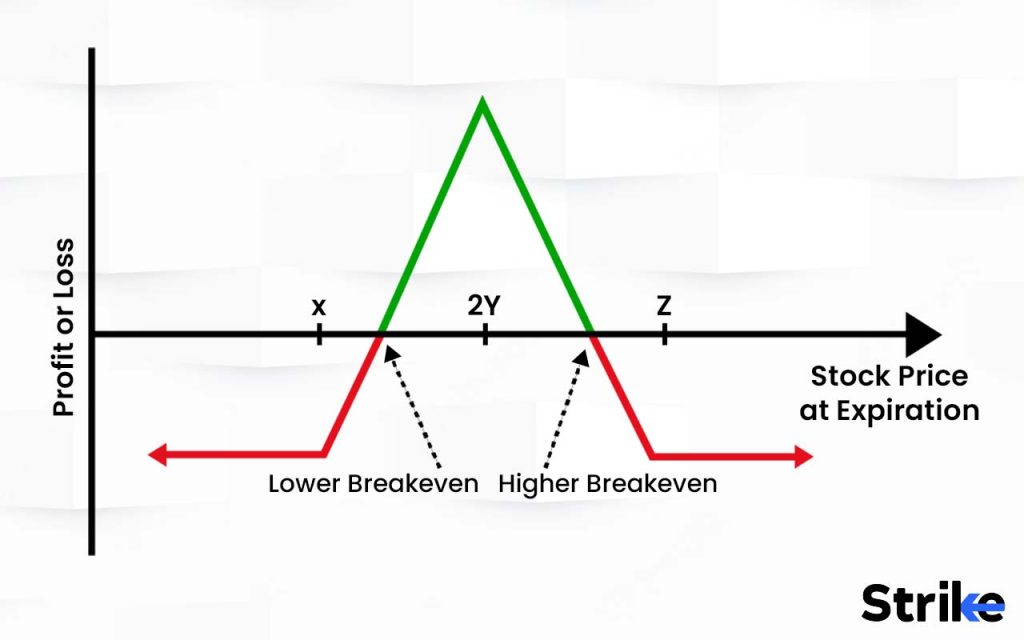
Butterfly spreads establish a defined maximum profit zone if the stock lands at the short strikes. They limit risk, with the maximum loss defined by the net debit paid if the stock concludes outside the wings. The cost structure of butterfly spreads is lower than long straddles, as the short spreads fund the long positions to diminish the debits. Butterflies enable traders to gain from stagnant stocks and rangebound rather than trending price action. They facilitate the potential for leveraged percentage returns if the stock settles near the midpoint of the strikes around the body.
Impending events that incite volatility, such as earnings reports or economic data, encourage rangebound stock action. Low implied volatility contributes to initially keeping the spread costs low. The expectation of volatility flattening or decreasing after events proves preferable. Sideway price action with the stock oscillating in a channel or trading range aligns well with butterflies. Stocks historically stagnating around catalyst events improve the odds.
Creating a butterfly requires identifying a stock with upcoming catalysts that might induce rangebound volatility. Then, sell a lower-cost upside call vertical at higher strikes and buy a higher-cost downside call vertical at lower strikes. Use options with the same expiration date for a defined trade duration. Adjust the strikes to lessen the net debit while optimizing the width of the body. Evaluate the resulting maximum risk, return, and breakeven points based on the net debit costs.
Butterfly spreads offer options traders a strategy for speculating on rangebound price action surrounding catalyst events. By combining vertical call spreads, butterflies create a defined maximum profit zone with wings to limit downside risks. Although the multi-leg structure carries the risks of untested wings and time decay, butterflies enable traders to benefit from stagnant stocks at a lower cost than straddles. Properly structured and timed, butterflies provide options traders with an additional tool to strategically trade volatility spikes within defined risk parameters.
5. Iron Butterfly
An iron butterfly entails selling an out-of-the-money put credit spread while also selling an out-of-the-money call credit spread, using the same underlying stock, expiration date, and strike prices. An iron butterfly creates a high probability range where the short strikes expire worthless for full credit if the stock stays within the sweet spot. The maximum gain equals the net credit received. The maximum loss is the difference between the wing strikes less the credit and occurs if the stock finishes outside the wings.
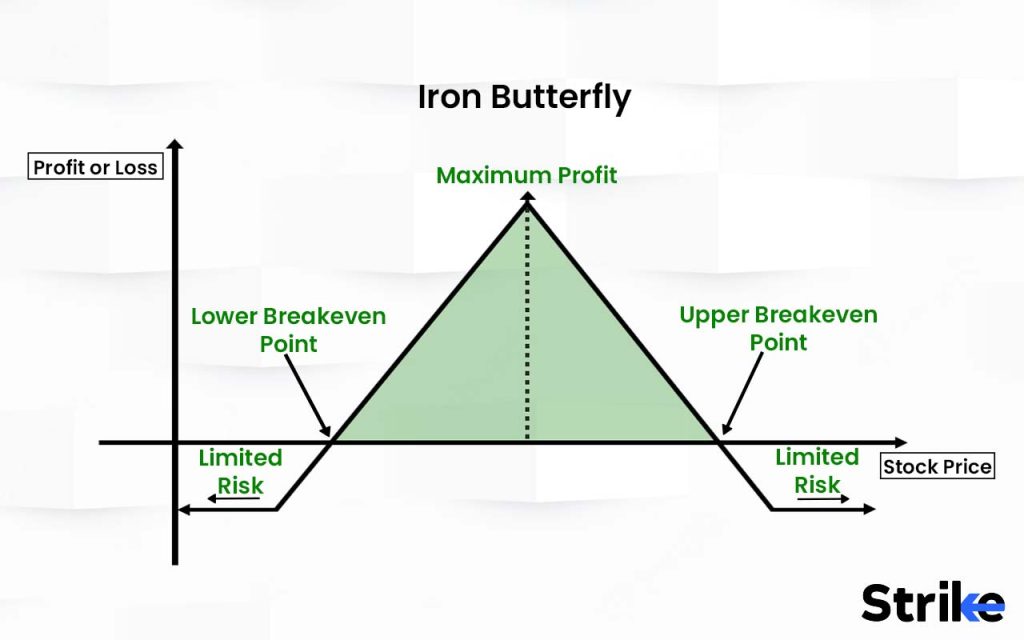
Iron butterflies facilitate a high probability of earning credits, with the chance of profitability surpassing 80% if executed correctly. The maximum return is the net credit received. If the strikes are out-of-the-money, the risk is limited, with the maximum loss capped between the wing strikes. Iron butterflies enable traders to benefit from stagnant stock price action and rangebound moves rather than directional ones. They also offer the potential for leveraged percentage returns if the stock lands near the midpoint of the strikes around the body.
Deploying iron butterflies becomes favorable under certain conditions. For instance, impending events that might trigger volatility, such as earnings reports and FDA rulings, drive rangebound stock action. Low implied volatility contributes to keeping the spread costs low for position entry. The expectation of volatility contraction after events is preferable. Sideway price trends with the stock oscillating in a channel align well with this strategy. Stocks that historically stagnate around catalyst events also improve the odds.
Iron butterflies come with both advantages and disadvantages. On the upside, they offer a high probability of credits, defined maximum returns, limited risk between strikes, the opportunity to benefit from stagnant stocks, and leveraged body returns. However, they also have downsides, including the need for accurate short-strike forecasts, bid/ask spread costs, early untested wing risks, time decay if the body is missed, and a capped upside limiting rewards.
Market conditions and volatility expectations greatly influence success. Therefore, investors should consider these potential advantages and disadvantages before using iron butterflies.
6. Iron Condor
An iron condor involves selling an out-of-the-money put credit spread and an out-of-the-money call credit spread on the same stock and expiration. An iron condor establishes a high probability range where the short strikes expire worthless for full credit if the stock stays within the sweet spot. The maximum gain is the net credit received. The maximum loss is the difference between wing strikes less the credit and happens if the stock is outside the wings.
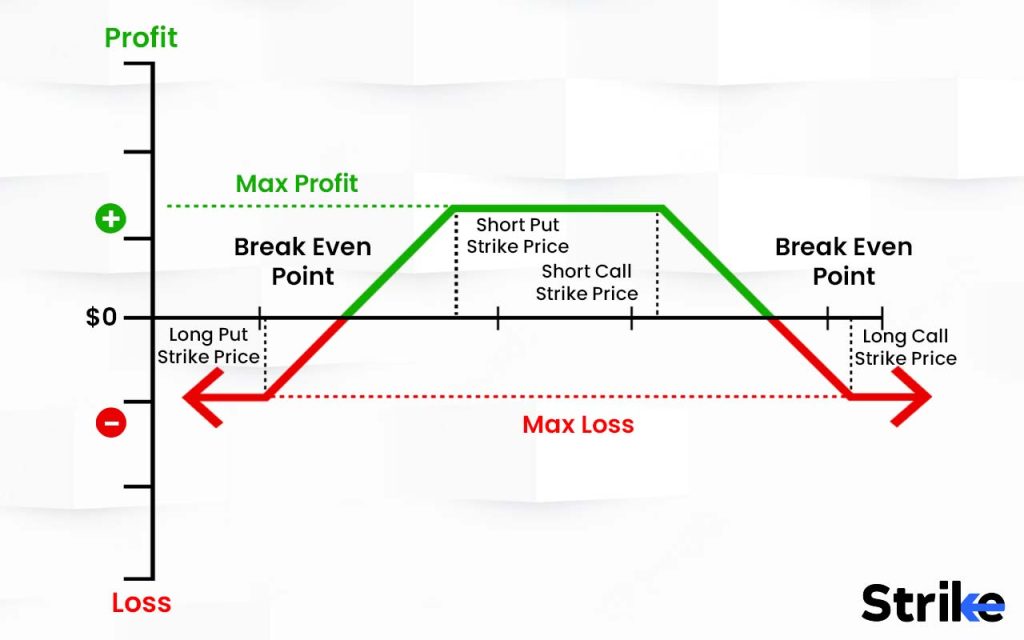
Iron condors have a high probability of earning credit if built properly, with over 80% likelihood of profitability. The maximum return is clearly defined as the net credit received. The risk is limited between the wing strikes, with maximum loss capped between the outer strike prices. Iron condors allow benefiting from stagnant stock price action and rangebound moves rather than directionality. There is potential for leveraged percentage returns if the stock finishes near the midpoint of the strikes around the body.
Upcoming events that may spark volatility, like earnings releases and clinical trial results, drive rangebound stock action. Low implied volatility helps keep the spread costs down for position entry. Expecting volatility contraction after events is preferable. Sideways price action with the stock oscillating in a channel aligns well. Stocks that historically stagnate around catalyst events improve the odds.
To construct an iron condor, identify a stock with upcoming catalysts that may create rangebound volatility. Sell an out-of-the-money put credit spread at lower strikes. Sell an out-of-the-money call credit spread at higher strikes. Use options all expiring on the same date for a defined trade duration. Adjust the strikes to optimize credit income while minimizing the wingspreads. Evaluate the maximum gain, loss, and breakeven points based on the net credit received.
Iron condors give options traders a strategy to earn credits from rangebound stock action into expiration. By combining OTM credit call and put spreads, iron condors establish a high probability zone between the short strikes. Though they have defined risks, short spreads face challenges like untested wings and time decay. When built and timed properly, iron condors allow traders to trade anticipated volatility spikes within strict risk parameters tactically.
7. Combination
A combination strategy involves simultaneously utilizing two or more different options techniques on the same underlying stock. A combination strategy example is a collar that combines a protective put and a covered call. A strap consists of a long put and two long calls. Combinations allow traders to generate multi-faceted positions aligned with their market outlook. The blended approaches provide flexibility to customize risk and reward.
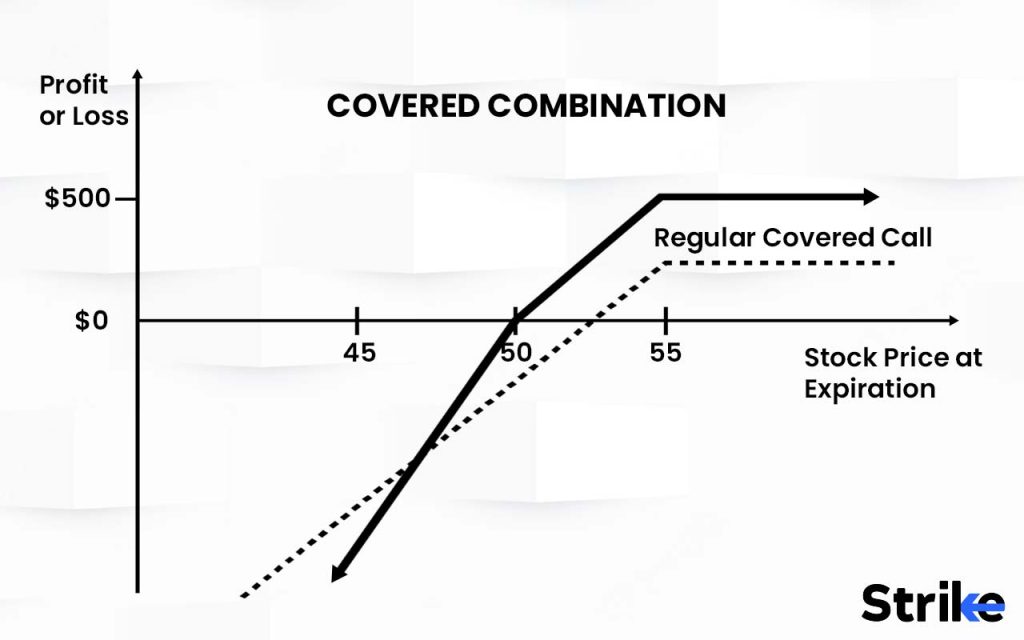
Combination option strategies offer traders several advantages. They provide exposure across a wider range of market conditions, with bearish, bullish, and neutral combinations available. Combinations allow flexibility in risk management by mixing safer and more speculative strategies. They enhance risk-reward profiles by blending upside potential with downside protection. The multiple positions provide additional levers to adjust based on price action. Creative combinations give unique payoff opportunities and potential edges.
Certain best practices help generate effective combination trades. The component strategies should match the overall directional bias. Aggressive and protective strategies should be balanced appropriately. Correlations between the legs should be evaluated to ensure consistent entries and exits. Total debit or credit costs should be assessed holistically. Built-in flexibility to adjust is key. It helps to start with simple combinations before attempting more advanced structures.
Constructing a combination trade involves several steps. First, identify the prevailing market bias and target volatility level. Next, select compatible strategies to blend. Evaluate how the combined Greeks and risk metrics interact. Build the position legs based on current pricing and predetermined risk limits. Assess the overall results and make adjustments to optimize further.
Managing combination trades requires monitoring the overall position as a single integrated trade. Early exercise and assignment risks must be evaluated. Legs should be adjusted in tandem based on price action. Taking profits on winning legs is considered. Plans for unwinding the full combination should be defined upfront. Results should be tracked to improve future combination designs.
While combining options strategies adds complexity, the ability to blend multiple approaches offers experienced traders additional flexibility. By compiling complementary positions aligned with their outlook, investors generate enhanced risk-reward profiles. However, combination trades require thorough research, prudent position sizing, and vigilant monitoring to manage successfully. When applied judiciously based on sound analysis, combinations allow skilled options traders to push the boundaries of trade construction.
8. Risk Reversal
A risk reversal is an advanced options strategy that combines a long and short position in calls and puts on the same underlying asset to generate income or reduce risk exposure. A risk reversal allows traders to benefit from perceived mispricing between puts and calls based on volatility skews.
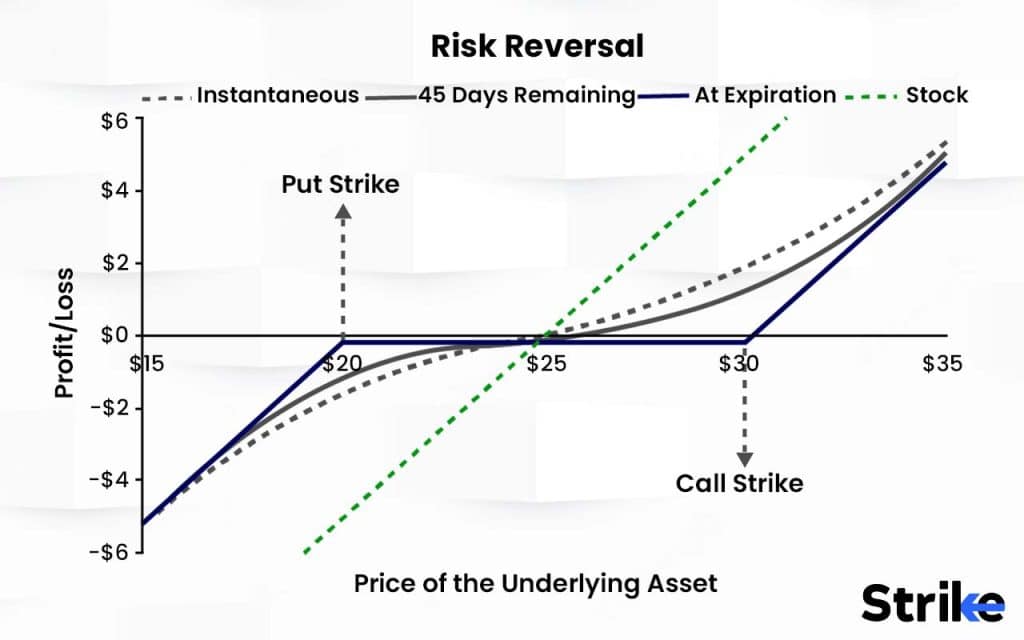
A basic risk reversal consists of selling out-of-the-money puts while simultaneously buying an equivalent number of out-of-the-money calls. The options share the same underlying asset and expiration date but have different strike prices.
The sale of the puts generates premium income, while the long calls provide upside exposure to the underlying asset. However, the long calls also carry a risk of loss if the asset price falls below the total premium collected.
Risk reversals are used when volatility skews have caused put options to become expensive relative to calls. The sale of richly valued puts helps fund the upside exposure bought through the calls. The strategy benefits if volatility declines or the underlying rallies.
A risk reversal combines one short put position with one long call position at different strikes but on the same asset and expiration date. For example,
Sell 10 puts at a Rs.45 strike price
Buy 10 calls at a Rs.55 strike price
The initial net premium paid or received depends on the relative value of the put and call options. If the puts are more expensive, the strategy can often be entered for a net credit. If the calls are more expensive, there would likely be a net debit paid.
Profit potential on the upside is unlimited above the long call strike. The purchased calls pay off if the underlying price rises enough to exceed their premium cost. Losses are capped at the difference between the strike prices less the premium collected from the short puts.
The maximum gain occurs if the underlying is above the long call strike at expiration. Maximum loss happens if the underlying is below the short put strike price at expiration. This defines a range for the strategy between the strike prices.
Risk reversals capitalize on volatility skews and relative mispricing between puts and calls on the same asset. They aim to capture distortive overpricing of downside puts versus upside calls.
Volatility skews refer to situations where an option chain’s pricing is significantly higher than calls, implying downside protection carries more value despite having the same underlying and expiration. This imbalance leads to expensive puts and relatively cheap calls.
Risk reversals sell rich put options to generate income for more attractively priced calls offering upside exposure. The sale of puts also offsets some downside exposure inherent in the long call position.
Traders utilize risk reversals when they expect volatility to decline, skews to normalize, and the underlying to rise. Other motivations include generating income or hedging other positions using the dynamics of volatility skews.
Proper implementation of risk reversals relies on the trader’s ability to identify actual mispricing between puts and calls, not just perceived imbalances. The short puts may maintain high implied volatility and premiums even with upside exposure purchased through the calls.
9. Long Call Butterfly Spread
A long call butterfly spread is an options strategy constructed using call options that offer limited risk and capped profit potential. A long call butterfly spread involves selling two calls at a middle strike price while buying one lower-strike call and one higher-strike call, all with the same expiration date.
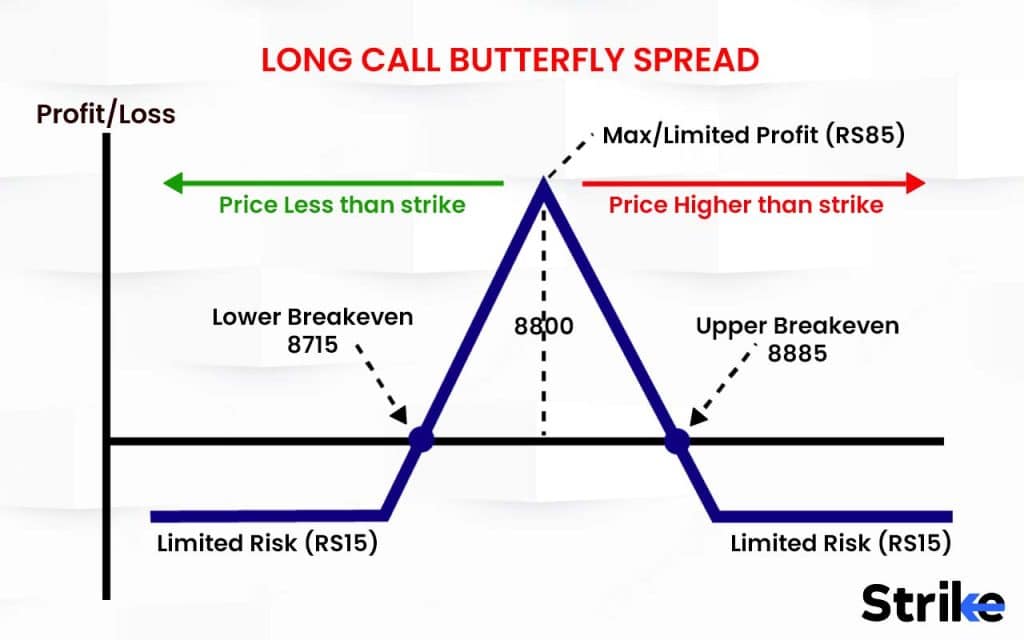
The long call butterfly aims to profit from low volatility and the underlying stock trading in a narrow range. Maximum gains are achieved at expiration if the stock settles at or near the mid-strike price. Potential losses are defined and limited based on the strikes used.
A long-call butterfly uses four call option legs at three different strike prices. The structure consists of the following.
Selling 1 call at the low strike
Buying 1 call at the mid-strike
Selling 1 call at the high strike
Buying 1 call at the mid-strike
For example, with the stock at Rs.50:
Sell 1 Rs.45 call
Buy 1 Rs.50 call
Sell 1 Rs.55 call
Buy 1 Rs.50 call
Net debit is typically paid to establish the trade, with maximum loss limited to the initial debit. Maximum potential profit is capped between the wings of the structure.
The long calls at the middle strike result in a position that profits from the stock settling at or near Rs.50 at expiration. The short calls at the low and high strikes help reduce the net cost but also limit the profit range.
The long call butterfly payoff diagram exhibits a symmetrical profit profile between the wings. It is ideal for situations where you expect low volatility and for the stock to remain in a trading range.
This strategy sacrifices upside profit potential for lower cost exposure to a stagnant or rangebound forecast. By selling options at the outer strikes, and the net debit is reduced to make the trade affordable.
The maximum loss is known before entering the trade. A long call butterfly offers capped risk, allowing precise exposure sizing relative to defined loss. Breakeven points are also established on both sides.
Maximum loss on a long call butterfly spread is equal to the initial net debit. This occurs at expiration if the stock settles below the lower wing or above the higher wing strike. The maximum loss represents the total premium paid.
Maximum profit is capped between the wings, calculated as the difference between the wing strikes less the net debit paid. The maximum is achieved if the stock finishes right at the middle strike price at expiration.
Breakeven points are calculated by adding the net debit to the lower wing and subtracting the net debit from the higher wing. The position breaks even if the stock is between these points at expiration.
The short options at the wings create obligations if assigned before expiration. You may be forced to sell stock at the lower strike or buy it at the higher strike.
To avoid early assignment risks, roll or close out positions as expiration approaches. You can also spread out expirations using a broken wing butterfly to stagger the timing of the legs.
The entire position is closed out at a loss if the stock moves outside the wings before expiration. Alternatively, by closing the threatened wing(s) and adjusting to a bull call or bear call spread, loss exposure can be reduced.
The long call butterfly is ideal for low-cost exposure, given a narrow, neutral outlook. Alternatives can be used to adjust cost, risk, and profit potential as needed.
10. Long Call Spread
A long call spread, also known as a bull call spread, is a basic options strategy constructed using only call options. A long call spread involves buying a call option with a lower strike and selling a call with a higher strike, with both having the same expiration date.
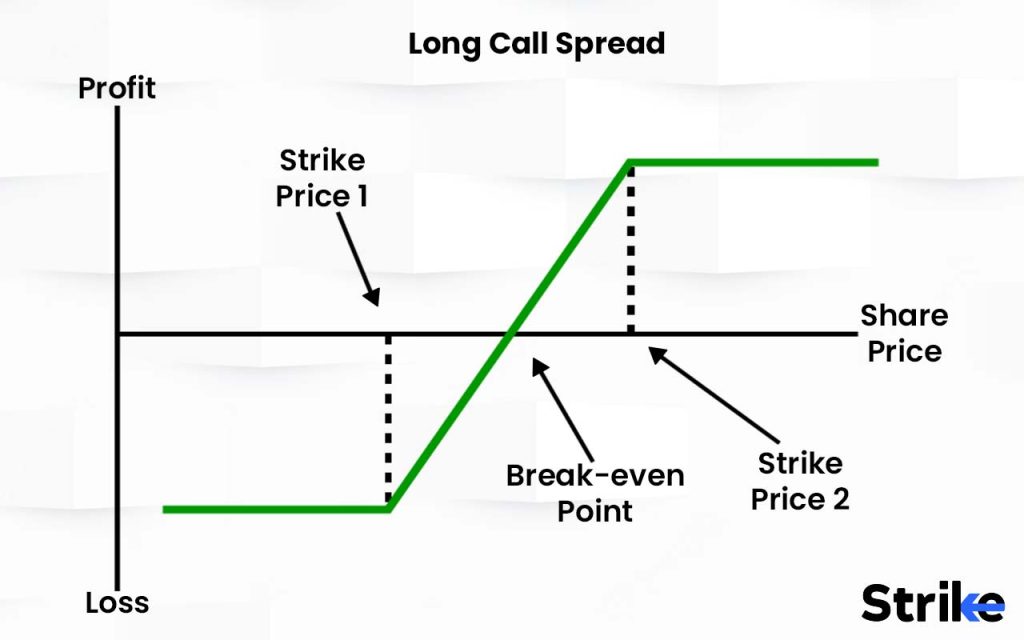
The long call spread aims to profit from moderate upside moves in the underlying asset. By selling a call at a higher price, the cost of the spread position is reduced. However, the short call also limits the maximum potential profit if the asset rises beyond that strike.
A long call spread consists of the following.
Buying 1 call option at a lower strike
Selling 1 call option at a higher strike
Both calls share the same underlying asset and expiration date. For example,
Buy 1 Rs.50 call
Sell 1 Rs.55 call
The Rs.50 call gives you exposure to upside gains if the stock rises past that price. Selling the Rs.55 call generates income to offset the cost but caps your profit above Rs.55.
Net debit is usually paid to establish a long call spread, with maximum loss limited to the initial debit. Maximum potential profit is the difference between the strike prices and the debit.
Long call spreads allow you to trade bullish sentiment at a fraction of the cost of owning the stock or buying calls. The sold call does cap your upside but also significantly reduces the premium you pay. The maximum risk is known upfront before entering the trade.
The maximum loss on a long call spread is limited and fixed. The worst-case scenario is for the stock to finish below the long call strike at expiration, causing the call options to expire worthless. Maximum loss is the initial net debit paid.
Maximum profit is earned if the stock settles above the short call strike at expiration. This allows the long call to be exercised while the short call expires worthless. Maximum profit is capped at the difference between the strike prices and the original debit.
Long call spreads offer straightforward, low-cost bullish exposure. Depending on your outlook, these alternatives provide flexibility by modifying risk, return, and directional assumptions.
11. Covered Call
A covered call, also known as a buy-write, is an options strategy combining long stock with short call options on the same underlying. In a covered call, the stock provides upside exposure, while the short calls generate premium income and hedge against limited gains.
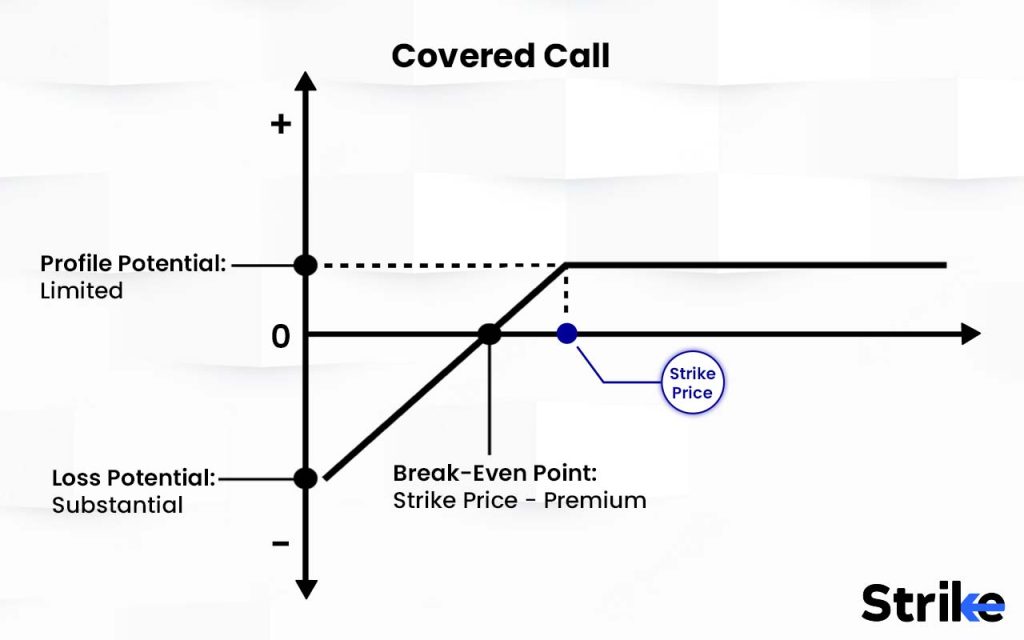
Covered calls involve buying or currently owning shares of the underlying stock and then selling call options on the same number of shares that you own. It caps your upside at the strike price but allows you to collect income from call premiums sold against the long stock position.
To implement covered calls, you must already own the underlying stock (not necessarily from the call sale date). The steps involve buying or currently owning the stock and selling calls on the same number of shares.
For example, owning 100 shares of XYZ stock and then selling 1 XYZ 50 call option against it.
The short call obligates you to sell your shares at Rs.50 if assigned. This caps your upside if XYZ rises past 50. However, you receive income from selling the call that lowers your stock purchase cost basis.
Covered calls allow long stockholders to earn additional income from their shares without having to sell. You get paid for offering upside exposure up to the call’s strike price via premiums.
Maximum possible loss is limited on covered calls. The worst case is the stock falling to Rs.0, but this loss is offset by the premium income received from the short call.
Maximum profit is capped at the strike price if assigned on the calls. Your shares would get called away at the strike, but you keep the premium. Any stock gains above the strike are forfeited.
The breakeven point is the stock purchase price minus the premium received. This is the net stock investment cost after factoring in call premiums.
Covered calls are a flexible strategy that offers income potential for stock investors comfortable with hedging against limited additional gains. The key is managing assignment risk and selecting favorable strike prices.
12. Protective Put
A protective put is an options trading strategy used to limit the downside risk of a long stock position. Protective Put involves buying put options on stocks you already own to provide some protection from a decline in the stock price. The put options act as insurance, giving you the right but not the obligation to sell your shares at the strike price if the stock falls below that level before option expiration. This helps limit your losses in a bear market while allowing you to participate in gains when the stock price rises.
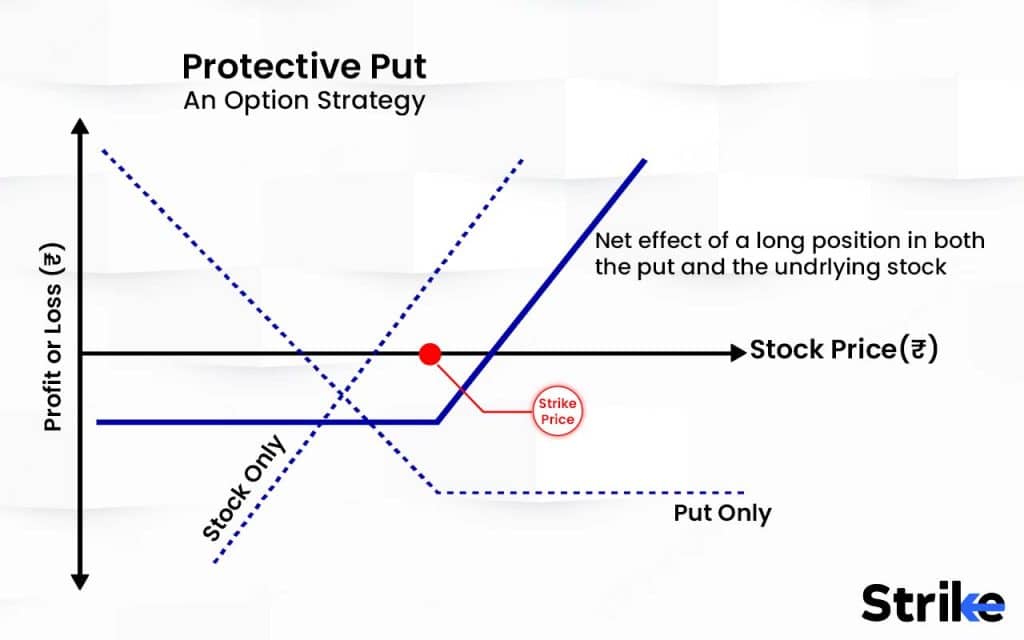
To implement a protective put strategy, you first establish a long position in the underlying stock. Then, you purchase put options on that same stock with a strike price below the current market price. The put options will have an expiration date and a premium cost that must be paid. The premium cost is the maximum amount you lose and represents the cost of the insurance protection. The goal is for the long stock position to rise while the put options expire worthless, allowing you to capture the stock’s upside. If the stock falls, the put options become more valuable and are sold to offset losses on the stock.
A key advantage of protective puts is they require less capital outlay compared to buying only put options outright. Since you already own the stock, you need to pay for the put premiums instead of the full cost of the shares. The puts provide downside protection without having to sell the stock. This allows you to ride out temporary dips and remain invested for potential rebounds. Protective puts also limit your risk to the known premium cost, unlike a long stock position, which has unlimited downside exposure from a continued market decline.
On the downside, the put options will expire worthless if the stock remains above the strike price, meaning the premium cost was lost. The puts may only return part of their value depending on how much the stock declines. There is also opportunity cost since the premium expense could have been used for other investments. Investors need to weigh the cost of hedging with puts versus the risk tolerance for the stock position. Protective puts work best for temporary protection when you are bullish on the stock long-term but want to limit the risk of short-term declines.
13. Long Put
A long put, also known as a simple put, is an options strategy used to profit from a decline in the price of the underlying stock. Long put involves purchasing options on a stock you expect to decrease in price. The put options give you the right, but not the obligation, to sell shares of the stock at the put’s strike price. The puts become valuable based on the difference between the strike and stock price if the stock price falls below the strike at expiration. You can then sell the puts for a profit or exercise to short the stock. High leverage potential and limited risk characterize a long put, which is a bearish options strategy.
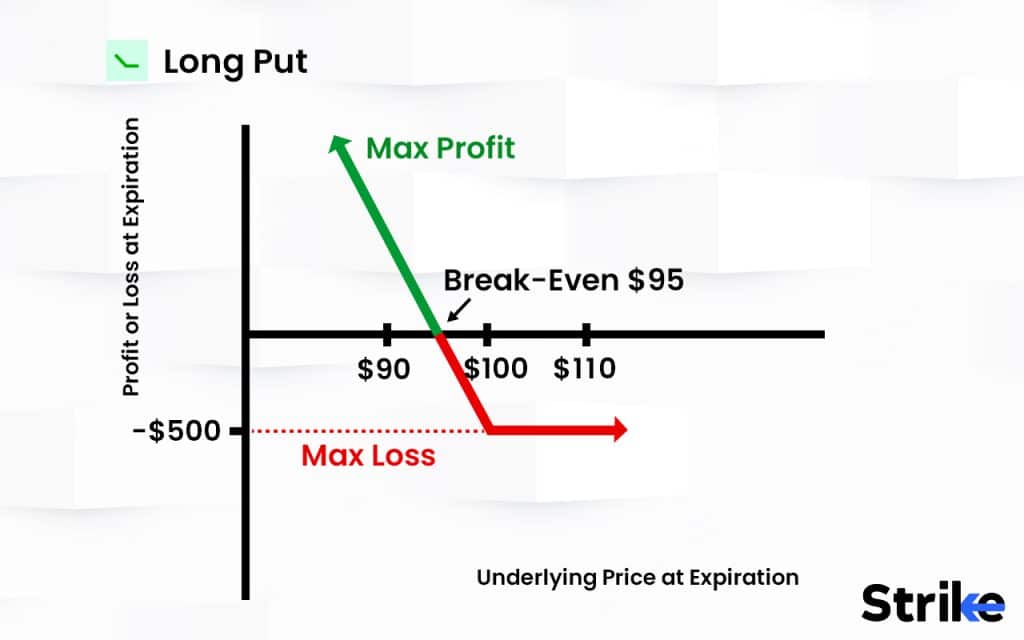
To implement a long put strategy, you first choose an underlying stock you believe will fall in price during the life of the options. Then, you purchase put option contracts on that stock with a strike price above the current market price. The higher strike maximizes profits if the stock declines substantially. You pay a premium cost per contract based on factors like the stock price, strike price, time to expiration, and volatility. The maximum risk on the trade is limited to the premium paid for the puts. The potential reward is the full downside move in the stock below the strike price, less the premium cost.
The profit on a long put comes from the appreciation of the put option if the stock price falls below the strike price. The more the stock drops, the higher the intrinsic value of the put becomes. You sell the puts to capture this profit any time before expiration as their premium rises. Alternatively, you exercise the puts to short shares of the stock at the strike price if your broker allows. Maximum profit occurs if the stock drops to zero. Losses are limited to the premium paid since you are under no obligation to buy or sell the stock if the puts expire worthless.
What Do Option Strategies Mean?
An option trading strategy refers to employing different options, techniques, and combinations to profit from potential market moves. Option strategies give traders the flexibility to execute strategies based on their outlook and goals. The most common option strategies aim to generate income, speculate on price direction or hedge an existing portfolio.
Strategies utilize call options, which give buyers the right to purchase a stock, and put options, which give buyers the right to sell a stock. Complex strategies combine multiple legs and varying strike prices, expirations, and bullish/bearish positions to create defined risk profiles. Option trading strategies are grouped into three main categories: Directional Strategies, Non-Directional Strategies, and Income Strategies.
Directional Strategies are implemented by traders when they have a particular bullish or bearish outlook on the market direction. They aim to profit from the price of the underlying stock moving either up or down. There are several types of directional strategies, including Long Calls, Long Puts, Covered Calls, and Protective Puts.
Long Calls and Long Puts profit from an upward and downward move, respectively, by purchasing options. Covered Calls involve holding a stock and selling call options against it to gain income from the call premiums. Protective Puts involve holding a stock and buying put options as a safeguard against declines.
Non-directional or volatility strategies, on the other hand, aim to profit from changes in implied volatility rather than the direction of price. Traders implement this strategy when they expect volatility expansion or contraction. These strategies include Straddle, Strangle, and Butterfly Spread. Straddle and Strangle strategies involve holding calls and putting options to capitalize on sharp movements in either direction. Butterfly Spread combines call-and-put options to profit from a lack of movement and a narrow range.
Income Strategies generate returns from options premiums rather than stock movement. These are utilized by traders when they are seeking recurring cash flow. The strategies under this category include Covered Call Writing, Cash Secured Puts, and Credit Spreads. Beyond these core strategies, there are more complex techniques like ratios, diagonals, condors, and iron condors that combine multiple option legs. These advanced strategies create more nuanced risk graphs with varied probabilities of profit and loss.
The selection of strategies depends on various factors such as market conditions, risk tolerance, outlook, and portfolio goals. They are defined by key components including Directional Bias, Leverage, Risk Profile, Time Decay, Investment Amount, Strike Selection, Expiration Choice, and Exit Strategy. Each of these components plays a crucial role in shaping an option strategy and its potential outcomes.
Within each strategy, traders adjust components like strike selection, expiration, number of contracts, timing, and structure to match their specific market thesis, risk appetite, and account size. Strategies should align with detailed entry, management, and exit plans based on upside targets and stop-loss limits. Ongoing adjustments hedge and optimize based on changing conditions.
Options allow flexibility but require research and monitoring to balance risk versus reward for planned strategies. Understanding the dynamics between the stock price, time left, implied volatility, and strike selection enables traders to shift bets as the probabilities evolve. Executing the right option strategies for a trader’s goals and forecast takes knowledge, experience, and prudent risk management. With so many choices, traders must take care to use strategies properly matched to their circumstances and abilities.
How Do Option Strategies Work?
Options strategies work by aiming to profit from various market conditions based on combinations of call-and-put options. They utilize the unique characteristics of options to meet goals like generating income, speculating directionally, reducing risk, or exploiting volatility. Strategies define maximum profit, maximum loss, breakeven points, and risk graphs that represent potential price movement outcomes. Traders employ strategies matching their risk profile, account size, outlook, and objectives.
How to know which strategy to use?
The selection of the right options strategy is based on the evaluation of your market outlook, risk tolerance, portfolio goals, account factors, and experience level, and then finding a strategy that corresponds with your specific circumstances and plan. For instance, buying calls or bull call spreads may be suitable if you have a bullish outlook. Covered calls or cash-secured puts could work if income generation is your goal. For capital preservation, strategies like collars and credit spreads help limit risk.
The level of risk you’re comfortable with also influences your strategy selection; for instance, some strategies, like debit spreads, have a defined maximum loss, while others, like naked calls, come with an undefined risk. Account factors, such as margin usage and trading timeframe, also play a vital role in determining feasible strategies.
As your outlook and goals evolve, it’s essential to reevaluate your strategies periodically. The key is to avoid using leverage recklessly and, instead, deliberately match high-probability strategies to your profile while controlling risk and steering clear of approaches you don’t fully understand. While options provide flexibility, they require prudent use based on careful analysis.
What Does Bearish Mean as Option Strategies?
A bearish outlook in option strategies refers to the belief that an underlying asset like a stock is likely to decline in price. Bearish strategies employ various puts, credit spreads, and combinations to profit from a downward trajectory. These trades do well when the market prices fall from overvaluation, weakening fundamentals, or overall negative sentiment. Traders utilize bearish option strategies to speculate on downside price moves or hedge existing long portfolio positions against potential drops.
The most basic bearish option strategy is simply buying put options on a stock. Also called long puts or simple puts, the purchased put contracts give you the right but not the obligation to sell shares at the strike price anytime before expiration. If the stock falls below the put strike, the put gains intrinsic value, which is able to be realized by selling the contract or exercising the option. Maximum loss is limited to the premium paid if the puts expire worthless. A potential gain is the stock moving to zero.
Bear put spreads involve buying puts at one strike while selling puts at a lower strike to offset the cost. Maximum gains are capped at the width between strikes less net debit paid. Risk is reduced from outright long puts. Bear call spreads sell call options against long puts to further lower cost basis and define risk at the expense of limiting profit potential. Vertical bear spreads trade off lower capital requirements for a higher probability of smaller gains.
Credit put spreads sell high strike puts and buy lower strike puts of the same expiration. The short put’s premium income exceeds the long’s debit cost for a net credit. Gains accrue while the stock stays above the short put strike at expiration. The long put defines maximum loss. This has a high probability of profit with defined, limited risk.
Combination strategies like put backs put diagonals, and double diagonals employ multiple option legs over different expirations to create new bearish risk profiles. These advanced trades require experience and monitoring but generate profit in specialized scenarios. The variety of bearish strategies allows traders to isolate and exploit declining market moves based on outlook and risk tolerance.
What Does Bullish Mean as Option Strategies?
A bullish outlook refers to the belief that an underlying asset, like a stock, is likely to rise in price. Bullish strategies employ various calls, debit spreads, and combinations to profit from an upward trajectory. These trades do well when market prices increase due to positive fundamentals, technical breakouts, or favorable market conditions. Traders utilize bullish option strategies to speculate on upside moves or leverage existing positions without further capital outlay.
The most basic bullish option strategy is simply buying call options on a stock. Also known as long calls, purchased call contracts give you the right but not the obligation to buy shares at the strike price anytime before expiration. If the stock rises above the call strike, the call gains intrinsic value, which is realized by selling the contract or exercising the option. Maximum loss is limited to the premium paid if the calls expire worthless. The potential gain is unlimited as the stock price appreciates.
Bull call spreads involve buying calls at one strike while selling calls at a higher strike to offset the cost. Maximum gains are capped at the width between strikes less net debit paid. Risk is reduced from outright long calls. Bear put spreads sell put options against long calls to further lower cost basis and define risk at the expense of limiting profit potential. Vertical bull spreads trade off lower capital requirements for a higher probability of smaller gains.
Debit call spreads buy lower strike calls and sell higher strike calls of the same expiration. The long call’s higher premium cost exceeds the short call’s credit for a net debit. Gains accrue while the stock rises beyond the breakeven point at expiration. The short call defines maximum profit. This has a high probability of profit with defined, limited risk.
Combination strategies like call backspreads, call diagonals, and double diagonals employ multiple option legs over different expirations to create new bullish risk profiles. These advanced trades require experience and monitoring but generate profit in specialized scenarios. The variety of bullish strategies allows traders to isolate and exploit increasing market moves based on outlook and risk tolerance.
How Does Bullish On Volatility Work?
Bullish on-volatility trading involves taking long positions in volatility-linked derivatives to profit from an increase in market volatility. Volatility refers to the magnitude and speed of fluctuations in the price of the underlying security. Being bullish on volatility means expecting volatility to increase. Traders construct non-directional option strategies designed to profit from rising volatility without needing the stock to move in a particular direction.
Volatility is a key component in options pricing. Higher implied volatility increases the premium value of both calls and puts due to greater expected moves in the stock before expiration. If volatility expands after establishing long option positions, the greater premium builds intrinsic value into those options.
Strategies like long straddles and long strangles are bullish volatility plays utilizing both calls and puts. Long straddles buy at-the-money calls and puts with the same strikes. The dual options position profits whether the stock makes a big move up or down. Long strangles buy out-of-the-money calls and puts. This benefits from a substantial move in either direction while allowing some rangebound movement before activation.
To manage bullish volatility trades, closely monitor the impact of time decay on the long options positions. If the stock pins near the sold strikes as expiration approaches, adjustments may be needed to avoid losing the entire premium paid. Such adjustments could involve rolling positions further out in time or converting to alternative spread structures.
The optimal exits for bullish volatility trades entail closing positions after a substantial increase in implied and realized volatility drives up option values. Letting the winners ride enables maximizing the volatility divergence. Set profit take and stop loss orders based on percentage gains or maximum loss limits.
How Does Bearish On Volatility Work?
Being bearish on volatility means expecting volatility to decrease. Traders construct non-directional option strategies designed to profit from declining volatility without needing the stock to move in a particular direction.
Volatility represents the magnitude and speed of price fluctuations. Lower implied volatility reduces the premium value of both calls and puts due to expectations of smaller moves in the stock before expiration. If volatility declines after establishing short option positions, the lower premium builds profit into those trades.
Strategies like short iron condors and short butterflies benefit from contracting volatility. Short iron condors sell an out-of-the-money put and call while buying further OTM puts and calls to create a net credit. The short options expire worthless if the stock holds within the wide strike range. Short butterflies sell ITM calls and put while buying ATM options. The short options decay faster if volatility drops.
Technical Factors play a critical role. Traders should review past volatility around significant events such as earnings announcements, product releases, and mergers. Understanding how these events have influenced volatility in the past helps in forecasting future volatility trends, thereby informing the strategy.
Upcoming Catalysts are another aspect to consider. Any events that could reduce uncertainty and thus decrease volatility should be taken into account. This could include scheduled company announcements or broader economic events that may affect the stock’s volatility.
Strike Selection is a crucial element in bearish volatility strategies. For strategies like iron condors, traders should choose equidistant strikes that are wide enough to withstand some volatility. For butterflies, choosing at-the-money (ATM) short strikes would be a more appropriate choice.
Expiration is another key consideration. Using shorter-dated options allows traders to benefit from an anticipated near-term plunge in volatility quickly. It’s important to keep in mind that shorter-dated options will react more quickly to changes in implied volatility.
To manage bearish volatility trades, monitor the impact of time decay on the short options positions. If the stock approaches the long strikes before expiration, adjustments may be required to avoid losing the entire initial credit received. Adjustments could involve rolling positions further out in time or converting to alternative spread structures.
The optimal exits for bearish volatility involve closing positions after a substantial decrease in implied and realized volatility drives down option values. Letting winning short options expire worthless enables maximizing the volatility decline. Set profit take and stop loss orders based on percentage threshold targets or maximum loss limits.
How Does Option Strategy Influence the Profit and Loss Chart?
An option strategy’s profit and loss chart provides a risk graph that illustrates the tradeoff between maximum profit, maximum loss, and breakeven points. The P&L chart demonstrates how the structure of different positions produces unique risk profiles. Traders analyze P&L diagrams when evaluating strategies to assess the probability of profit against potential risks.
The most basic strategies of buying calls or puts produce simple linear P&L graphs. Long calls gain value steadily as the stock price rises above the strike price. Profit is theoretically unlimited past the breakeven point where the stock price exceeds the strike plus premium paid. Loss is limited to the premium amount if the stock finishes below the strike.
Long puts gain value steadily as the stock declines below the strike. Maximum loss is limited to the premium paid if the stock closes above the strike. Profit potential extends down to the stock being worthless but is capped at the strike price due to the limited liability inherent in options.
More complex strategies utilizing spreads produce nonlinear P&L diagrams reflecting the multiple legs. Bull call spreads exhibit upside gains limited by the width between the bought and sold strike prices. The maximum loss is defined by the net debit paid. Bear put spreads have limited profit between strikes and maximum loss at the net premium paid.
Iron condors combine bull put and bear call spreads to create P&L graphs with two upside and downside breakeven points. Maximum gain at expiration is the initial credit received. Maximum loss is also clearly defined. Probability favors a small gain or scratch trade. Ratio spreads skew P&L charts, reflecting unequal numbers of bought versus sold contracts.
Calendar spreads display evolving P&L graphs across their duration as the near-term short options decay faster than the longer-term longs initially. As the expiration dates converge, the graph flattens with a declining maximum profit potential. Diagonal spreads combine changing strikes and expirations to build asymmetrical risk graphs.
Straddles and strangles have unlimited profit potential, but maximum loss is limited to the debits paid. Their P&L graphs are V-shaped, showing wide breakeven zones requiring substantial upside or downside movement to become profitable. Time and volatility are key factors influencing their evolving risk profiles.
The P&L chart enables visualizing the risk boundaries across the spectrum of potential market price moves. Evaluating the risk graphs in relation to the probability and potential size of gains versus losses allows traders to select appropriate strategies aligned with their market thesis, risk tolerance, and potential opportunity. Comparing P&L diagrams for various strategy alternatives helps highlight the unique risk profiles involved.
Traders also monitor the evolving P&L chart of open positions to track how current stock prices, time decay, and volatility changes impact the risk boundaries. Adjustments may be warranted if the probability cone shows the current stock price drifting out of the optimal profit zones. Savvy options traders utilize the information in P&L charts to not only select ideal strategy structures but also effectively manage open positions.
How Does Option Strategy Use to Investigate Payoff Graphs?
Options traders use payoff graphs, also known as profit and loss diagrams, to analyze the risk profiles of different trading strategies visually. The payoff graph maps out the possible profit and loss scenarios at expiration based on a range of hypothetical underlying prices. Each options strategy produces a unique payoff graph that demonstrates its breakeven points, maximum gain, maximum loss, and probability of earning a profit.
Examining the payoff graph is a key step in selecting an appropriate strategy for a particular market outlook and risk tolerance. Comparing payoff diagrams illustrates how strategies differ in their risk-reward tradeoffs. Traders look for graphs that align with their market bias and goals.
For basic long call and put positions, the payoff graphs slope upward or downward linearly. Loss is limited to the premium paid, while profit potential is uncapped. The breakeven point is the strike plus premium cost. This unlimited upside or downside reflects the inherent leverage of options.
Vertical spreads, like bull call spreads, exhibit payoff graphs that rise and then flatten out at the maximum profit cap defined by the spread width. The maximum potential loss is the net debit paid. Diagonal and calendar spread display evolving payoff graphs across their duration as the components interact.
Are there More Basic Strategies to be Used for Market Movement?
Yes, there are additional strategies like collars, married puts, etc. Below are four additional basic option strategies that are used to benefit from different market movements,
Collars
This strategy involves holding a long stock position while simultaneously buying protective puts and selling covered calls against that stock. The long puts provide downside protection in case the stock price falls sharply. The short calls generate premium income to offset the put purchase cost but limit upside potential. Collars allow hedging risks on existing portfolio positions.
Married Puts
It entails purchasing put options to protect a long stock holding. Unlike collars, married puts do not sell calls against the stock, so upside potential remains intact. The puts provide insurance against downside moves. Married puts allow remaining bullish on a stock for the long term while hedging near-term risks.
Long Straddles
Buying both a call and put option on the same underlying stock with the identical strike price and expiration date. Maximum loss is limited to the premiums paid. Requires a significant move up or down to profit from volatility expansion. Utilized when expecting a large directional move ahead of a major catalyst event but uncertain of the direction.
Ratio Call Backspreads
It involves buying calls at one strike and then selling more calls at a higher strike to reduce cost. Caps upside at sold strike but leverages downside if the stock falls. Combines limited risk with non-directional volatility exposure. Uses options leverage more efficiently based on outlook.
Each of these strategies utilizes basic calls and puts in straightforward combinations to generate directional exposure, profit from shifting volatility, or hedge risks. New options traders apply these basic leveraged structures to match their market outlook without taking on major risks or complexities. They provide accessible building blocks for strategically benefiting from potential market movements.
Does Covered Calls, Collars, and Protective Puts Use When You Have an Existing Position in The Underlying Shares?
Yes, covered calls, collars, and protective puts are option strategies commonly used when you already hold an existing long position in the underlying stock.
Can Spreads Involve Buying and Selling Other Options?
Yes, spreads in options trading can involve combinations of buying and selling multiple other types of options, not just calls and puts.
Does Straddles Profit Even When the Market Moves Up to Down?
Yes, it straddles profit when the market makes a substantial move, either up or down.


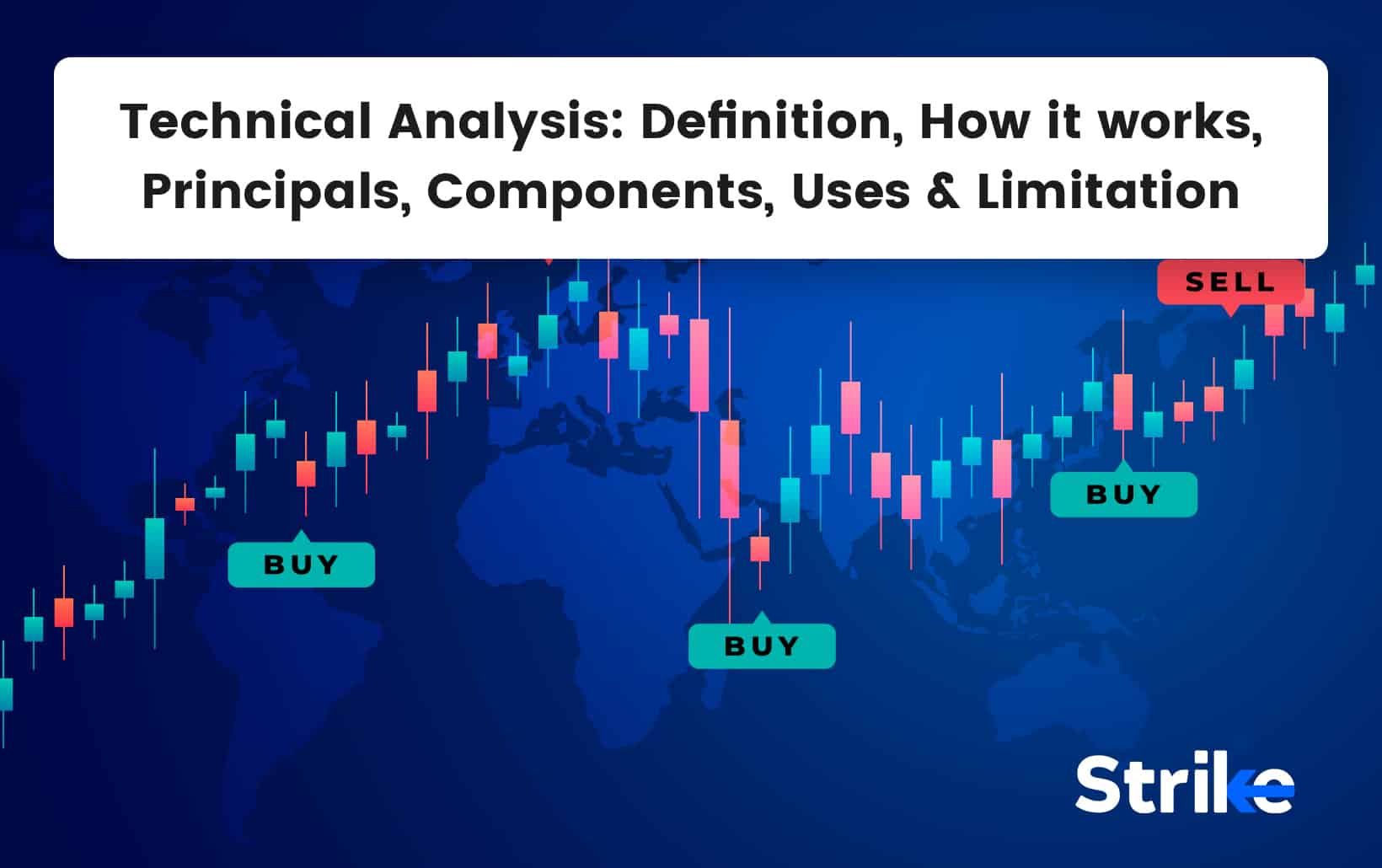
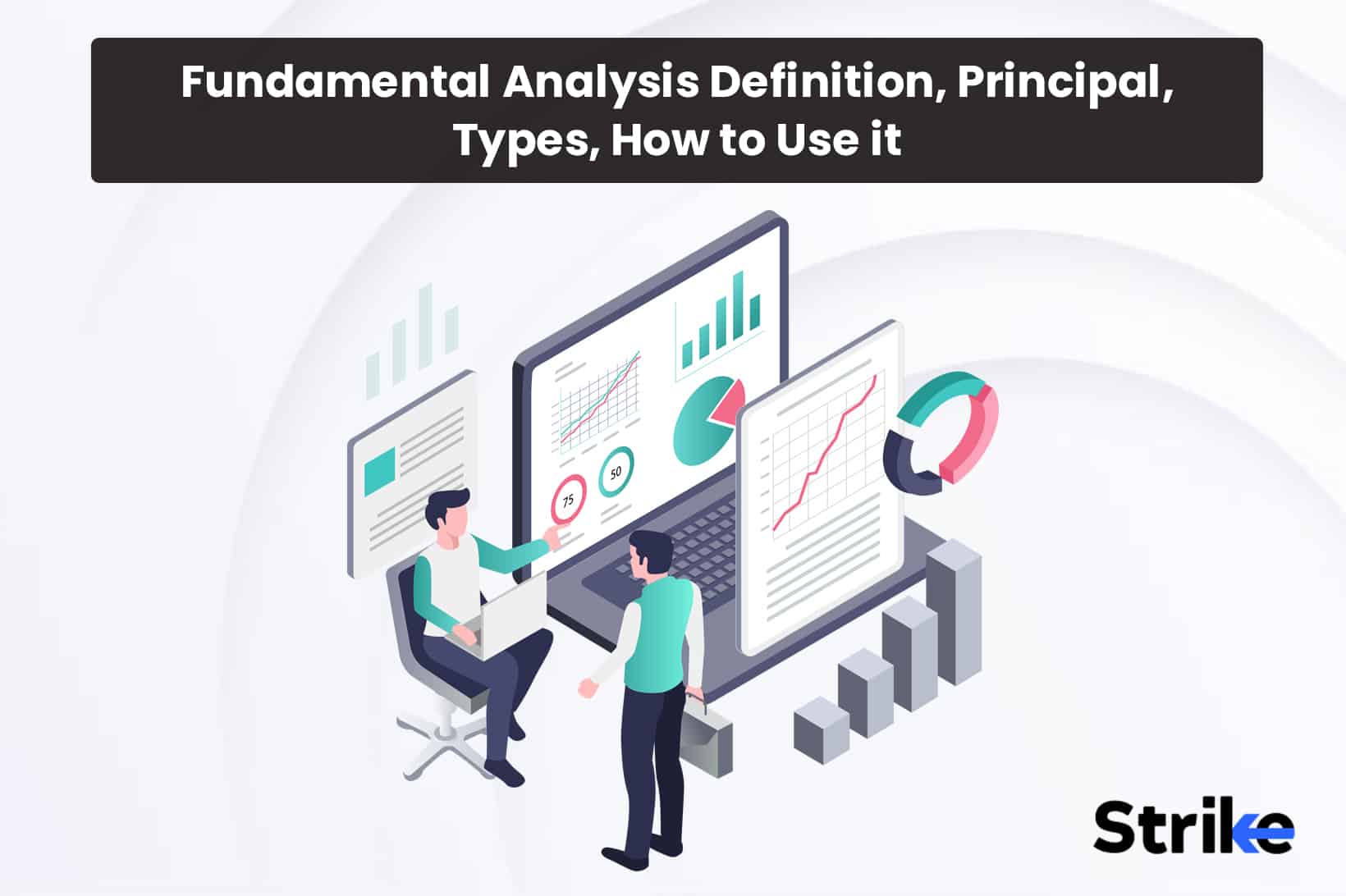







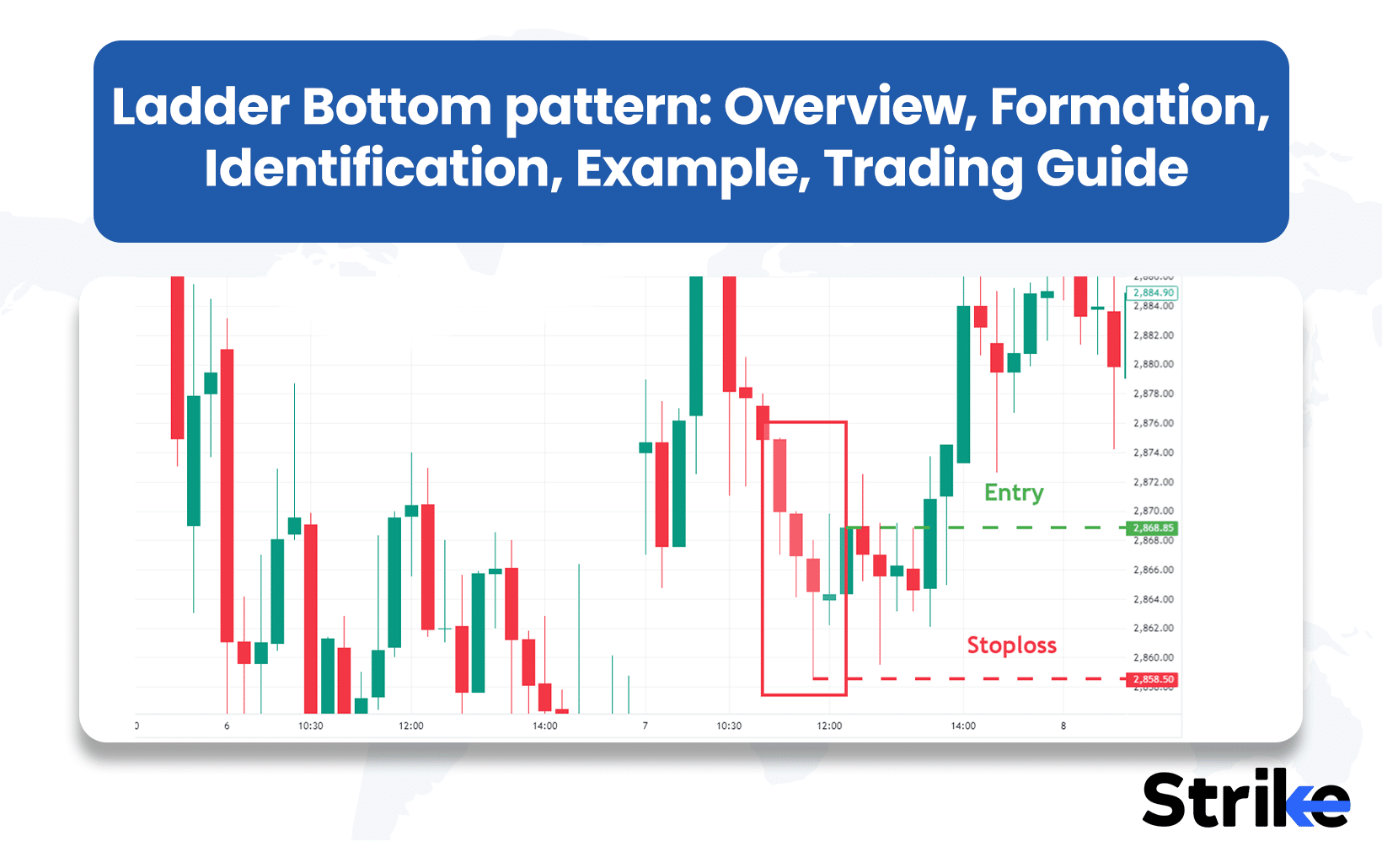




No Comments Yet.